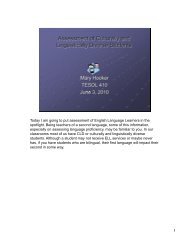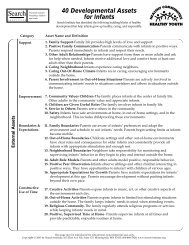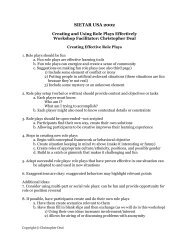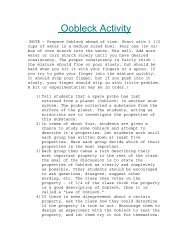A Critical Analysis of the Business Case for Diversity
A Critical Analysis of the Business Case for Diversity
A Critical Analysis of the Business Case for Diversity
You also want an ePaper? Increase the reach of your titles
YUMPU automatically turns print PDFs into web optimized ePapers that Google loves.
Management CommunicationQuarterlyhttp://mcq.sagepub.com"We Don’t Want Complaining Women!" A <strong>Critical</strong> <strong>Analysis</strong> <strong>of</strong> <strong>the</strong><strong>Business</strong> <strong>Case</strong> <strong>for</strong> <strong>Diversity</strong>Linda PerritonManagement Communication Quarterly 2009; 23; 218 originally publishedonline Sep 11, 2009;DOI: 10.1177/0893318909343122The online version <strong>of</strong> this article can be found at:http://mcq.sagepub.com/cgi/content/abstract/23/2/218Published by:http://www.sagepublications.comAdditional services and in<strong>for</strong>mation <strong>for</strong> Management Communication Quarterly can befound at:Email Alerts: http://mcq.sagepub.com/cgi/alertsSubscriptions: http://mcq.sagepub.com/subscriptionsReprints: http://www.sagepub.com/journalsReprints.navPermissions: http://www.sagepub.com/journalsPermissions.navCitations http://mcq.sagepub.com/cgi/content/refs/23/2/218Downloaded from http://mcq.sagepub.com by on May 19, 2010
“We Don’t WantComplainingWomen!” A <strong>Critical</strong><strong>Analysis</strong> <strong>of</strong> <strong>the</strong><strong>Business</strong> <strong>Case</strong> <strong>for</strong><strong>Diversity</strong>Management CommunicationQuarterly23(2) 218 –243© The Author(s) 2009Reprints and permission: http://www.sagepub.com/journalsPermissions.navDOI: 10.1177/0893318909343122http://mcq.sagepub.comLinda Perriton 1AbstractThe author explores how <strong>the</strong> corporate discourse <strong>of</strong> “<strong>the</strong> business case”works to frame, restrict, and depoliticize <strong>the</strong> discussion <strong>of</strong> gender in <strong>the</strong>workplace. In turn, bemused and surprised by <strong>the</strong> ease with which womenhave been persuaded it is not “businesslike” to complain, <strong>the</strong> authorexplores how women’s linguistic choices shape <strong>the</strong>ir corporate lives.By examining <strong>the</strong> didactic and embedded “gender work” <strong>of</strong> a women’sleadership event and reflecting on her own, occasional, weakness <strong>for</strong> <strong>the</strong>discourse, <strong>the</strong> author contributes to <strong>the</strong> understanding <strong>of</strong> how a seeminglypositive and popular communication strategy reproduces unequal genderedrelationships in <strong>the</strong> workplace. The author rejects <strong>the</strong> claim that using abusiness case discourse is an effective strategy in improving <strong>the</strong> recognition,promotion, and rewarding <strong>of</strong> women in organizations.1 University <strong>of</strong> York, UKCorresponding Author:Linda Perriton, The York Management School, University <strong>of</strong> York, Heslington, York, YO10 5DD,United KingdomEmail: ljp8@york.ac.ukDownloaded from http://mcq.sagepub.com by on May 19, 2010
Perriton 219Keywordsfeminism, equality, corporate discourseThe study <strong>of</strong> corporate discourses can help us understand gendered relationshipsin business because how things are talked about reflect current powerrelationships in <strong>the</strong> workplace (Ahmed, 2007; Zanoni & Janssens, 2003).But corporate discourses <strong>of</strong> gender have raised as many questions <strong>for</strong> thosewho study <strong>the</strong>m as <strong>the</strong>y have provided answers—<strong>for</strong> example, What does itmean to “sell” diversity to an organization? How is diversity achieved and<strong>for</strong> what purpose? What “bargains” get struck between agents in this process(Hunter & Swan, 2007, p. 378)? As researchers have pursued <strong>the</strong>selines <strong>of</strong> inquiry, <strong>the</strong>y have also raised questions about <strong>the</strong> way organizationsindividuate difference and cast it as something that can be described, measured,and utilized <strong>for</strong> increased business productivity (O’Leary &Weathington, 2006). Kirby and Harter (2003) identified corporate trainingevents as a potentially useful source <strong>of</strong> data to examine corporate diversitydiscourses, and, in this study, I have followed <strong>the</strong>ir suggested approach andcollected data from a business conference to analyze how gender is framedas an issue <strong>of</strong> productivity, as a “business case” <strong>for</strong> diversity.<strong>Diversity</strong> initiatives are an area <strong>of</strong> political sensitivity <strong>for</strong> many organizations.As a result, communication researchers have difficulty gainingaccess to private training events to do <strong>the</strong> sort <strong>of</strong> research called <strong>for</strong> byKirby and Harter (2003). Opportunities to hear organizations talk publiclyabout <strong>the</strong>ir gender communication strategies are also rare. I was <strong>for</strong>tunate toreceive an advertising flyer <strong>for</strong> a “women and leadership” conference that<strong>of</strong>fered participants an opportunity to receive instruction by “experts” onhow gender issues should be communicated within business organizations. 1The two-day event was coorganized by an equality consultancy and aninternational business conference firm. The conference was a mix <strong>of</strong> plenarysessions, panel discussions, and individual presentations coveringtopics such as work/life balance challenges and creating women’s networks.The event carried <strong>the</strong> prominent sponsorship <strong>of</strong> a range <strong>of</strong> established multinationalorganizations and featured representatives from those sameorganizations as speakers and panelists.The conference speakers and panelists placed particular emphasis on <strong>the</strong>need to present gender in a way that did not challenge <strong>the</strong> central values anddiscursive preferences held by business. Participants were repeatedly assuredthat this “business case” approach was a successful communicative strategy.But instruction on how to speak appropriately to employers about gender and/or race turned out to be nothing more complex than restricting communicationDownloaded from http://mcq.sagepub.com by on May 19, 2010
220 Management Communication Quarterly 23(2)about diversity issues to those <strong>of</strong> individual merit, responsibility, and pr<strong>of</strong>it.The experience <strong>of</strong> <strong>the</strong> didactic aspect <strong>of</strong> <strong>the</strong> conference confirmed O’Learyand Weathington’s (2006) <strong>the</strong>sis about <strong>the</strong> individuation <strong>of</strong> difference and <strong>the</strong>links to pr<strong>of</strong>itability. My linguistic analysis <strong>of</strong> <strong>the</strong> conference data (not just <strong>the</strong>sessions that covered communication strategies) revealed <strong>the</strong> degree to which“gender work” is embedded within corporate discourses. The embedded“gender work” in tandem with restricted language choice enables gender to bedepoliticized in many workplaces.The aim in presenting a critical analysis <strong>of</strong> <strong>the</strong> business case <strong>for</strong> diversityis to aid understanding <strong>of</strong> how communication reproduces gendered relationshipsin <strong>the</strong> workplace and to contribute to <strong>the</strong> study <strong>of</strong> organizations from asocial constructionist understanding <strong>of</strong> discourse (<strong>for</strong> o<strong>the</strong>r examples, seeAhl, 2004; Ashcraft & Mumby, 2004; Deetz, 1992; Fairhurst, 2007; Kirby &Harter, 2001; Lair, Sullivan, & Cheney, 2005; Tracy & Tre<strong>the</strong>wey, 2005). Thefirst section <strong>of</strong> <strong>the</strong> article establishes <strong>the</strong> background to <strong>the</strong> rise <strong>of</strong> businesscase. I start by providing an example <strong>of</strong> its use from my own pr<strong>of</strong>essionalexperience and <strong>the</strong>n explain its take-up by practitioners who felt that a rightsbasedapproach to gender equity was ineffective. This section <strong>of</strong> <strong>the</strong> articleends by outlining how <strong>the</strong> business case has been criticized by gender scholars.The second section outlines <strong>the</strong> methods used in <strong>the</strong> analysis <strong>of</strong> <strong>the</strong> data,and <strong>the</strong> third illustrates how gender is commonly framed in a way thatremoves any potential <strong>for</strong> challenge <strong>of</strong> <strong>the</strong> dominant values and behaviors <strong>of</strong>business. Depoliticization is achieved by combining <strong>the</strong> effects <strong>of</strong> (deliberate)restrictions in language and a whole raft <strong>of</strong> o<strong>the</strong>r (unacknowledged) discursivemodifications. The discussion section examines whe<strong>the</strong>r it is possible tochallenge dominant discourses successfully by using <strong>the</strong> business case as acarrier discourse <strong>for</strong> more radical ideas. I compare <strong>the</strong> use <strong>of</strong> <strong>the</strong> business casediscourse in diversity initiatives to its use in introducing corporate socialresponsibility (CSR) concepts. The article concludes that <strong>the</strong> strategic use <strong>of</strong>a business case discourse is bound to fail. Its use can only maintain, not challenge,existing inequalities, and it is important that we find ways to legitimizemoral arguments in corporate discourse.The Rise and Rise <strong>of</strong> <strong>the</strong> <strong>Business</strong> <strong>Case</strong>The business case discourse has been an established part <strong>of</strong> organizationallife <strong>for</strong> many years, but that does not mean that those who use it understandit. This much is obvious from my own work history. In <strong>the</strong> 1980s, I worked<strong>for</strong> an international financial services firm as a human resource consultant.My role was to work with business units who were experiencing difficultiesDownloaded from http://mcq.sagepub.com by on May 19, 2010
Perriton 221in implementing central policies and procedures. One <strong>of</strong> my assignmentswas to visit a unit that was finding it difficult to retain staff; a substantialnumber <strong>of</strong> employees had left our company to work at a local supermarketwhere <strong>the</strong> pay and conditions were considered superior. The message that<strong>the</strong> supervisors wanted me to return to senior management with was that “itwas unfair and demoralizing <strong>for</strong> financial service pr<strong>of</strong>essionals to be paidless than supermarket employees.” I remember being surprised at what Iinterpreted as <strong>the</strong>ir naivety. The company had located this unit in a geographicallyremote and economically depressed area as a direct result <strong>of</strong>local tax reductions, subsidized building costs, and <strong>the</strong> availability <strong>of</strong> cheaplabor. The fact that <strong>the</strong> company could staff this unit at minimum wagelevels was a large factor in deciding to create it. My reply, to <strong>the</strong> obviousirritation <strong>of</strong> <strong>the</strong> supervisory team who were on <strong>the</strong> receiving end <strong>of</strong> my corporatehomily, was that appeals based on fairness or morale were unlikelyto result in success. Unless <strong>the</strong> management at this site could demonstratethat <strong>the</strong> high turnover <strong>of</strong> staff had an economic cost to <strong>the</strong> company thatoutweighed <strong>the</strong> benefit it received from employing <strong>the</strong>m at low wages, <strong>the</strong>situation would remain <strong>the</strong> same.I doubt if anyone else who was in <strong>the</strong> room that day remembers my minilectureon <strong>the</strong> importance <strong>of</strong> couching complaint in an appropriate <strong>for</strong>m.Perhaps, <strong>the</strong> only reason I remember is that my current research interestsgive <strong>the</strong> speech a post-hoc significance it did not have at that time. However,<strong>the</strong> incident is a useful illustration <strong>of</strong> several key aspects <strong>of</strong> <strong>the</strong> use <strong>of</strong> <strong>the</strong>business case in a typical workplace. The first thing to note is failure tocommunicate using <strong>the</strong> dominant (or “preferred”) discourse is interpretedas incompetence. In appearing to ignore <strong>the</strong> economic context in which <strong>the</strong>company is operating, you are judged—as I judged <strong>the</strong> staff I was speakingto—as being out <strong>of</strong> touch with “reality” (i.e., naive). The second point tonote is that <strong>the</strong> dominant discourse is sufficiently pervasive so that enoughmembers <strong>of</strong> <strong>the</strong> organization automatically use and maintain it (I did withoutever being instructed to do so) but that it is not universally used(o<strong>the</strong>rwise my advice to <strong>the</strong> supervisory staff would not have been necessary).Finally, <strong>the</strong> discourse is one that can be used to protect <strong>the</strong> organizationfrom a wide variety <strong>of</strong> challenges, not just those arising from gender or race.In <strong>the</strong> example above, <strong>the</strong> refusal to pass on a complaint because it is notappropriately expressed as a financial issue means that <strong>the</strong> organization didnot have to respond to a challenge regarding <strong>the</strong> diminished reputationalcapital that its work represented.Although <strong>the</strong> business case discourse had been an established part <strong>of</strong>corporate life <strong>for</strong> many years, <strong>the</strong>re were still some issues that were articulatedusing older, alternative discourses. This was true <strong>of</strong> appeals <strong>for</strong> genderDownloaded from http://mcq.sagepub.com by on May 19, 2010
222 Management Communication Quarterly 23(2)and racial equality in <strong>the</strong> workplace, which continued to be framed inEurope in terms <strong>of</strong> social justice until <strong>the</strong> mid-1990s (Greene, Kirton, &Wrench, 2005), although <strong>the</strong> business case <strong>for</strong> racial equality had been afeature <strong>of</strong> U.S. workplaces from <strong>the</strong> 1950s (Wilkins, 2004).The shift in rhetorical strategy since <strong>the</strong> 1990s regarding gender issueshas been attributed to management consultants who argued that it was necessaryto argue <strong>for</strong> <strong>the</strong> promotion <strong>of</strong> women into leadership positions usingan economic rationale and as a commonsense response to <strong>the</strong> threats <strong>of</strong>economic recession, demographic change, and globalization (Greene et al.,2005). Consultants found many organizations willing to purchase <strong>the</strong>iradvice on how to introduce diversity (i.e., gender and race) initiatives intoorganizations that had hi<strong>the</strong>rto seemed resistant to equal-opportunity programs.Senior managers (i.e., men) were thought to respond more positivelyto business-based diversity discourses ra<strong>the</strong>r than discourses <strong>of</strong> genderequity (Smithson & Stokoe, 2005). Moreover, by tapping into establishedmanagerial discourses (colloquially referred to as <strong>the</strong> money code), <strong>the</strong> case<strong>for</strong> diversity was able to be packaged in a way that would be more easilyaccepted by decision makers trained to rationalize behavior based on <strong>the</strong>bottom line (Kirby & Harter, 2003).So what were <strong>the</strong> key elements <strong>of</strong> this business-friendly “diversity” discourse?The key claims made <strong>for</strong> <strong>the</strong> approach (compiled from <strong>Business</strong>Link, 2007; Greene et al., 2005; Hutchings & Thomas, 2005) emphasize<strong>the</strong> promotion <strong>of</strong> more women and ethnic minority staff into leadershiproles, which will benefit <strong>the</strong> organization in several ways:••It will involve senior management in human resource planning,••enhance <strong>the</strong> organization’s ability to recruit from a diverse generalpopulation,••increase <strong>the</strong> range and depth <strong>of</strong> <strong>the</strong> skills <strong>of</strong> <strong>the</strong> work<strong>for</strong>ce,••improve staff retention,••increase <strong>the</strong> appeal <strong>of</strong> <strong>the</strong> organization to a wider customer basethrough <strong>of</strong>fering a more nuanced or differentiated service andproduct,••enhance <strong>the</strong> organization’s reputation in <strong>the</strong> community,••enhance <strong>the</strong> organization’s ability to predict and respond to customersfrom diverse backgrounds,••reduce discrimination allegations.Social groups outside <strong>the</strong> organization (e.g., “women” or “<strong>the</strong> Afro-Caribbean community” or “<strong>the</strong> Jewish community”) are viewed as potentialmarkets <strong>for</strong> products or services. But when <strong>the</strong>y are inside <strong>the</strong> organization, an
224 Management Communication Quarterly 23(2)movement toward human equality, au<strong>the</strong>nticity, self-improvement,democracy, freedom, and social progress;••belief that women should be unified in <strong>the</strong>ir opposition to oppressionand express its arguments and demands in a common voice;••belief that political organization should be collective; and••awareness that barriers to equality <strong>of</strong> opportunity and outcome in<strong>the</strong> workplace include low pay, differential treatment <strong>of</strong> part-timeand casual workers, gendered division <strong>of</strong> labor, and low status <strong>of</strong>work considered to be “female.”The irony is that <strong>the</strong> business case discourse has proved just asineffectual in bringing about change as <strong>the</strong> equality discourse. But <strong>the</strong>reare no calls <strong>for</strong> <strong>the</strong> business case approach to be abandoned because it isstill believed that <strong>the</strong> approach ensures people “with a specific kind <strong>of</strong>politics” (Ahmed et al., 2006, p. 37) get a hearing in corporate settings.A more persuasive explanation <strong>for</strong> <strong>the</strong> tenacious grip that <strong>the</strong> businesscase discourse has on <strong>the</strong> framing <strong>of</strong> gender relationships is <strong>the</strong> changingmacroeconomic policy choices <strong>of</strong> government. Blackmore (2006), <strong>for</strong>example, observed that <strong>the</strong> arrival <strong>of</strong> “business case” discourses coincidedwith a period <strong>of</strong> radical workplace restructuring when new public administrationapproaches adopted principles from private business. Fur<strong>the</strong>rmore,<strong>the</strong> belief that diversity is something that can be capitalized on by an organizationto increase pr<strong>of</strong>it <strong>of</strong>ten accompanied <strong>the</strong> belief in <strong>the</strong> free marketand a less interventionist approach (Blackmore, 2006). Colling and Dickens(1998) also interpreted <strong>the</strong> rise <strong>of</strong> <strong>the</strong> business case discourse as “privatization”<strong>of</strong> <strong>the</strong> responsibility <strong>for</strong> promoting equality. They believed this was aresult <strong>of</strong> <strong>the</strong> state in its role as regulator standing back and encouragingequality, as an issue, to be appropriated by line management. Finally, <strong>the</strong>idea <strong>of</strong> “capitalizing” on diversity has been associated with <strong>the</strong> ef<strong>for</strong>t to gainnew markets as a result <strong>of</strong> globalization, with new flows <strong>of</strong> transnationalmigration and <strong>the</strong> shift to <strong>the</strong> service economy (Blackmore, 2006) all supportedby governments. Ra<strong>the</strong>r than <strong>the</strong> state behaving as <strong>the</strong> regulator <strong>of</strong>business, <strong>the</strong> appearance has been one <strong>of</strong> business regulating <strong>the</strong> state. As aresult, corporate discourses such as <strong>the</strong> “business case” have gained greaterlegitimacy and have come to dominate policy debates.The business case approach clearly limits <strong>the</strong> fur<strong>the</strong>ring <strong>of</strong> women’sinterests in <strong>the</strong> workplace. Using a business case justification when discussinggender in organizations restricts both <strong>the</strong> types <strong>of</strong> appeals that womencan make and <strong>the</strong> range <strong>of</strong> outcomes that women can expect. The businesscase assumes that <strong>the</strong> only gender issue in <strong>the</strong> workplace is that <strong>of</strong> <strong>the</strong> underutilization<strong>of</strong> women’s ability in senior management roles. The business
Perriton 229Figure 2. Corresponding text sample illustrating co-occurrences <strong>of</strong> lemmas“talent” and “recruit”Talking Appropriately About <strong>the</strong> TalentUsing <strong>the</strong> significant lemmas from <strong>the</strong> analysis, I now demonstrate <strong>the</strong> waysin which gender, as an issue, is stripped <strong>of</strong> its potential to be political by <strong>the</strong>way it is positioned in corporate discourse. As outlined above, <strong>the</strong> “Womenand Leadership” conference was an unusual event because one <strong>of</strong> its obviousaims was to teach women how to talk appropriately about gender. It is <strong>the</strong>re<strong>for</strong>enot surprising that <strong>the</strong> corpus shows a <strong>for</strong>m <strong>of</strong> talk about gender that isinstructional in tone and intent. I refer to this sort <strong>of</strong> discursive approach asdidactic. But speakers also moderated <strong>the</strong>ir use <strong>of</strong> language in ways that wereunacknowledged and occurred much more frequently than didactic gendertalk. I refer to this discursive approach as embedded identity work.Didactic ElementsThe didactic elements revealed in <strong>the</strong> data provide us with an outline <strong>of</strong> <strong>the</strong>framework and tools with which business tries to manage claims by women,Downloaded from http://mcq.sagepub.com by on May 19, 2010
230 Management Communication Quarterly 23(2)ethnic minorities, and o<strong>the</strong>r traditionally underrepresented groups in seniormanagement groups <strong>for</strong> greater access to those positions. The data show amix <strong>of</strong> exhortations as to what women must start (and stop) doing if <strong>the</strong>y areto be recognized in organizations and attempts to get women to buy in tosuggested “solutions” such as women’s networks and flexible working.Throughout <strong>the</strong> conference, <strong>the</strong> liberal feminist discourse (i.e., <strong>the</strong> equalitydiscourse discussed earlier in this article) was repeatedly characterized as afailed discourse and its key phrases were not used. There were, <strong>for</strong> example, nooccurrences <strong>of</strong> <strong>the</strong> words or phrases: feminism, feminists (although “feminine”occurred 6 times), gender equality, equal opportunities, legislativepressure, women’s rights, ethnicity, race, disability, sexual orientation, sexism,or harassment. Not only was <strong>the</strong> equality discourse dismissed as ineffectualbut also were women explicitly told not to (a) identify collectively as womenand (b) use gender as <strong>the</strong> basis <strong>of</strong> complaint. It was so rare that women wereidentified as a group that it was far from clear, when <strong>the</strong> following advice wasgiven by one <strong>of</strong> <strong>the</strong> speakers, whe<strong>the</strong>r <strong>the</strong> “we” being referred to was womenor <strong>the</strong> corporate world: “We [have] realised that <strong>the</strong> one thing we don’t want—we don’t want complaining women! Don’t stay in a complaining role!” Womenwere warned that senior male managers would interpret an appeal to equalityas a “deficit model,” which was defined as “<strong>the</strong>re’s a problem, you’re a woman,you’re singled out, and you have to fix it.” The “business case” model was, incontrast, presented as something that would tempt <strong>the</strong> organization, through anemphasis on per<strong>for</strong>mance and pr<strong>of</strong>itability, to engage with gender. As one participantrelated, “[The choice is between] <strong>the</strong> deficit model <strong>of</strong> women fixing awomen’s problem or . . . a positive proactive way <strong>of</strong> pitching gender as a tangible,measurable asset.” The refusal to use <strong>the</strong> equality and discriminationdiscourse was highlighted by a male panelist.[O]ne <strong>of</strong> <strong>the</strong> things we haven’t talked about here really is <strong>the</strong> issue <strong>of</strong>discrimination. It is discrimination against women that women don’tprogress in <strong>the</strong> same way as men do in organizations, but I haven’<strong>the</strong>ard that word in <strong>the</strong> two days that I’ve been here.At this point, one <strong>of</strong> <strong>the</strong> representatives from <strong>the</strong> conference organizersstepped in to assure <strong>the</strong> panelist that <strong>the</strong>se issues would be followed up ina subsequent session. However, <strong>the</strong>y were not, but it was obvious from <strong>the</strong>panic caused by this intervention that existing gender relationships couldstill be challenged using older, more established equality discourses. Themomentary discom<strong>for</strong>t was soon smoo<strong>the</strong>d over by o<strong>the</strong>r panelists returningto <strong>the</strong> <strong>the</strong>me <strong>of</strong> how to speak appropriately.Downloaded from http://mcq.sagepub.com by on May 19, 2010
Perriton 231Senior managers, participants were told, should only be spoken to interms that <strong>the</strong>y understood and valued. Gender was not something thatcould be sold to <strong>the</strong>m on an emotional level as a societal good. Genderneeded to be trans<strong>for</strong>med into an asset that could be managed, accounted<strong>for</strong>, and translated into pr<strong>of</strong>itability. Organizations would remain deaf toany appeals that were not made directly to <strong>the</strong> bottom line <strong>of</strong> <strong>the</strong>ir pr<strong>of</strong>itand loss account.[I explain] to corporate women, how to pitch <strong>the</strong> gender debate to <strong>the</strong>Board to get a budget. Because that’s <strong>the</strong> number one option that youhave. You have to get a budget because if a corporate doesn’t give abudget . . . it gives no visibility.The main didactic work <strong>of</strong> <strong>the</strong> conference was done through <strong>the</strong> subsessionsthat each featured different solutions to <strong>the</strong> problem <strong>of</strong> underrepresentation <strong>of</strong>women at senior management levels. The lemmas within <strong>the</strong>se sessionsappeared as clusters, that is, lemmas that are statistically overrepresented in aparticular text within <strong>the</strong> corpus. For example, in <strong>the</strong> discussion thatrecommended women’s networks, <strong>the</strong> lemma “network” appears 93 times butonly a fur<strong>the</strong>r three times elsewhere in <strong>the</strong> corpus. In addition, <strong>the</strong> discussionaround work/life balance showed clustering <strong>of</strong> a number <strong>of</strong> lemmas related to<strong>the</strong> private realm (home, family, etc). Clusters, in <strong>the</strong> context <strong>of</strong> this corpus,represent lemmas that appear frequently because <strong>the</strong>y are <strong>of</strong>ficially sponsoredra<strong>the</strong>r than being less self-conscious in use across a range <strong>of</strong> texts and contexts.Conference speakers promoted women’s networks as a mechanism <strong>for</strong> <strong>the</strong>advancement <strong>of</strong> women into senior management positions. The speakersstressed that women’s networks could be sold to skeptical managers andcoworkers if treated like any o<strong>the</strong>r initiative. A woman’s network could gainlegitimacy by being allocated a budget and marketed correctly: “It must have abrand. What is <strong>the</strong> brand and reputation <strong>of</strong> your gender <strong>for</strong>um or women’snetwork. What’s its identity? It has to have a brand! You have to work at <strong>the</strong>brand to make it successful.” Networks also have to deliver benefits to womenwho participate in <strong>the</strong>m. Those who organized networks saw <strong>the</strong>m as opportunities<strong>for</strong> rein<strong>for</strong>cing <strong>the</strong> importance <strong>of</strong> global business knowledge, with <strong>the</strong>United States identified as <strong>the</strong> originator <strong>of</strong> new approaches:So we . . . pick <strong>the</strong> topics to change mindsets and give women knowledgeand strategies that will help <strong>the</strong>m to assist in networks. Thetopics that we choose are always very topical, we hear things comingDownloaded from http://mcq.sagepub.com by on May 19, 2010
232 Management Communication Quarterly 23(2)from <strong>the</strong> States, we’re straight onto it and we are feeding that into <strong>the</strong>networks in Europe.But <strong>the</strong>re was a warning to those who were interested in establishing anetwork in <strong>the</strong>ir own organization. Women—perhaps those who wereaware <strong>of</strong> <strong>the</strong> advice not to invoke <strong>the</strong> idea <strong>of</strong> women as a collective in <strong>the</strong>corporate workplace—were <strong>of</strong>ten unhappy about being associated with awomen’s network: “Perhaps <strong>the</strong> biggest surprise to me when I came to <strong>the</strong>UK three years ago was this [attitude <strong>of</strong>]—‘I don’t want to be part <strong>of</strong> awomen’s network . . . What would <strong>the</strong> men think?’” One organization haddecided not to use “women” in <strong>the</strong>ir network name—“we didn’t want tohave <strong>the</strong> word ‘women’ because <strong>the</strong>re were so many networks <strong>of</strong> associationswith women this, women that, etc.” Ano<strong>the</strong>r speaker reported thatmany <strong>of</strong> <strong>the</strong>ir clients grappled with <strong>the</strong> issue, knowing that if <strong>the</strong>y called ita women’s network, “you are making a cognitive statement that it is aboutwomen helping women to move ahead and women’s development.” Thespeakers showed a keen awareness <strong>of</strong> <strong>the</strong> scrutiny that <strong>the</strong>ir actions wereunder and stressed that women had to show that this activity brought individualknowledge or behavioral gains back to <strong>the</strong> organization:You have to walk away [from a network meeting] with new thinking,new thoughts, new stuff and that’s what will make <strong>the</strong> members inyour corporate organizations, <strong>the</strong> o<strong>the</strong>r women, men and <strong>the</strong> boystake notice <strong>of</strong> what you are saying.Some speakers went fur<strong>the</strong>r than worrying about “what <strong>the</strong> men wouldthink.” One consultancy representative spoke <strong>of</strong> <strong>the</strong> need <strong>for</strong> networks todeliver productivity gains to <strong>the</strong> sponsoring organization. They recommended“gender <strong>for</strong>ums” ra<strong>the</strong>r than women’s networks, using <strong>the</strong>following justification:[Corporations] want <strong>the</strong> best combination and synergy in this becausethat gives greater innovation, greater productivity, you work better,etc., all <strong>the</strong> economic reasons. So some organizations are making [ashift to gender <strong>for</strong>ums] so that <strong>the</strong>y are bringing men in so that <strong>the</strong>men are educated about how women work.Nobody in <strong>the</strong> audience appeared to find it ironic that one consultancyproduct that was designed to support and develop women was being used<strong>for</strong> <strong>the</strong> development <strong>of</strong> men.Downloaded from http://mcq.sagepub.com by on May 19, 2010
Perriton 233Embedded Identity WorkI now address how <strong>the</strong> women at <strong>the</strong> conference deployed degendered corporatediscourse in an attempt to capture <strong>the</strong> “doing” <strong>of</strong> gender and“crafting” <strong>of</strong> self (Ashcraft & Mumby, 2004) in <strong>the</strong> corpus and <strong>the</strong> ongoingef<strong>for</strong>ts to demonstrate an appropriate corporate gender identity. The firstnotable feature <strong>of</strong> this embedded gender work is prevalence <strong>of</strong> <strong>the</strong> lemma“thinking,” in preference to “feeling.” Managing diversity, as we have seenin <strong>the</strong> didactic elements <strong>of</strong> <strong>the</strong> discourse, is an appeal that is made to <strong>the</strong>corporate head, ra<strong>the</strong>r than <strong>the</strong> heart. The lemma “think” appears 225 timesin <strong>the</strong> corpus, as does its similarly cerebral relation “know” (104 times). Incontrast, <strong>the</strong> lemma “feel” is underrepresented across all <strong>of</strong> <strong>the</strong> sessions andoccurs an equal number <strong>of</strong> times as “believe”—just 12 times each.The most significant word in terms <strong>of</strong> <strong>the</strong> number <strong>of</strong> occurrences in <strong>the</strong>corpus is “woman” at 293. Of <strong>the</strong> 67 times that <strong>the</strong> word “man” is used in<strong>the</strong> data, it appears in close association with “woman” on 42 occasions.The frequency <strong>of</strong> <strong>the</strong> co-occurrences indicates that <strong>the</strong> discourse aims to bean inclusive one, stressing an even-handed approach to gender issues ra<strong>the</strong>rthan drawing attention to women as a group in need <strong>of</strong> remedial action. Forexample,this whole debate has got to appeal to men and to women and it’s gotto be an inclusive debate. And I think that unless it is inclusive, it willalways be seen as doing favours <strong>for</strong> women to taking time <strong>of</strong>f.we’ve approached growing a business hopefully sustainably that worksboth <strong>for</strong> men and <strong>for</strong> women at different bases and at different ages.As mentioned earlier, corporate diversity discourses might stress <strong>the</strong>different talents and attributes different social groups bring to an organization,but <strong>the</strong> preference is to individualize difference. Claims <strong>for</strong> specificqualities held by women or ethnic groups were absent from <strong>the</strong> discourse.Where it was not possible to use inclusive language (i.e., “men andwomen”), <strong>the</strong> management practitioners at <strong>the</strong> workshop referred to“talent” or “people” instead. Speakers created <strong>the</strong> impression <strong>of</strong> a degenderedand deracialized organizational landscape by using <strong>the</strong> lemma“people” 181 times. For example,We’re looking <strong>for</strong> <strong>the</strong> best people to bring into <strong>the</strong> company and we’relooking <strong>for</strong> people to progress through <strong>the</strong> company on <strong>the</strong> basis <strong>of</strong>merit.Downloaded from http://mcq.sagepub.com by on May 19, 2010
234 Management Communication Quarterly 23(2)We do have very numerous programmes that are focused on trainingand development that do help people to develop.We spend a lot <strong>of</strong> money recruiting and developing a number <strong>of</strong> talentedpeople—and a large proportion <strong>of</strong> women—and un<strong>for</strong>tunatelywe are losing <strong>the</strong>m.Both <strong>the</strong> lemmas “people” and “talent” were frequently associated with<strong>the</strong> activities commonly referred to in business case arguments (i.e.,recruitment, <strong>the</strong> market, diversity, advancement, <strong>the</strong> company, work, jobs,and teamwork). In contrast, employees are surveyed, have perceptions,participate, attend courses, and are managed impacted, and measured. Thelack <strong>of</strong> permission within this discourse <strong>for</strong> individuals to identify with any<strong>of</strong> <strong>the</strong> established categories <strong>of</strong> difference (i.e., race, gender, or disability)was evident in <strong>the</strong> way that respondents spoke during plenary discussions.One woman, standing to ask a question <strong>of</strong> a panelist, introduced herself bysaying “As a diverse person . . .”Given <strong>the</strong> emphasis on inclusivity in <strong>the</strong> discourse, <strong>the</strong> discussion <strong>of</strong>domestic responsibilities represents a considerable problem as gender anddomestic responsibilities have to be discursively “managed.” Lemmas thatwere overrepresented in a session on work/life balance included “home,”“household,” “husband,” and “life”; <strong>the</strong> lemma “wife” does not occur in<strong>the</strong> corpus. Heterosexuality was assumed to be <strong>the</strong> norm (<strong>the</strong>re were fivereferences to marriage). But when discussing home and household issues,inclusivity was maintained by suggesting that adjustments designed to helpwomen fulfill child care responsibilities were open to all:I think a lot <strong>of</strong> <strong>the</strong> discussion we’ve had is about caring issues becausethis whole debate has got to appeal to men and to women and it’s gotto be an inclusive debate. And I think that unless it is inclusive, it willalways be seen as doing favours <strong>for</strong> women to taking time <strong>of</strong>f.Women’s (mostly full-time) child care responsibilities were treated as if<strong>the</strong>y were <strong>the</strong> same as men’s (mostly occasional) child care activities.Citing an example <strong>of</strong> how to make <strong>the</strong> work/life balance debate relevant tomen, a panelist presented <strong>the</strong> positive message <strong>of</strong> how men were alsomaking use <strong>of</strong> flexible working option: “[Male colleague] coaches football—hisson plays in a football team—he comes in very early but leavesat 4.30 on a Wednesday because he coaches football that afternoon.”Compare <strong>the</strong> relatively minor impact <strong>of</strong> a male colleague coaching hisson’s football team in this account (noting also <strong>the</strong> approval that <strong>the</strong>Downloaded from http://mcq.sagepub.com by on May 19, 2010
Perriton 235colleague comes into work “very early” to make up <strong>for</strong> his early departure)with <strong>the</strong> adjustments that are necessary <strong>for</strong> a female coworker: “But also,ano<strong>the</strong>r colleague <strong>of</strong> mine has two young children, now she works fourdays in <strong>the</strong> <strong>of</strong>fice but also takes work home on Friday and works fromhome on a Friday.” The discourse shifts its emphasis from accommodationto “choice” when a woman is judged as giving less than full-time attentionto <strong>the</strong> business or business environment. One <strong>of</strong> <strong>the</strong> most significant cooccurrencelemmas <strong>of</strong> “choice” is “individual” and “personal.” Women areconsidered to be making good decisions about <strong>the</strong>ir working life when <strong>the</strong>ymake <strong>the</strong>m (as a business would do) on <strong>the</strong> basis <strong>of</strong> a cost-benefit analysis:I think individuals have a far better choice, sometimes like <strong>the</strong>y don’twant to make <strong>the</strong>m, but <strong>the</strong>y’re available.so you can choose to be flexible and make less money or you couldmake a lot <strong>of</strong> money and hang yourself along <strong>the</strong> way. It’s a choice.It’s <strong>the</strong>re.The implication <strong>of</strong> <strong>the</strong>se statements is that it is <strong>the</strong> individual womanand not <strong>the</strong> organization that is expected to make choices. One <strong>of</strong> <strong>the</strong> panelistsadmitted that one <strong>of</strong> <strong>the</strong>ir company’s senior management roles wasjob-shared between two (male) executives each working a 56-hr week. Theunchallenged assumption is that organizations require full-time commitmentand continuity. Managers are required to service <strong>the</strong> needs <strong>of</strong> <strong>the</strong>organization, and it was <strong>the</strong>re<strong>for</strong>e up to individual women to decidewhe<strong>the</strong>r <strong>the</strong>y could make <strong>the</strong> necessary time commitment. For example,<strong>the</strong>re are different stages in people’s lives and people have got tomake that relevant in terms <strong>of</strong> <strong>the</strong>ir working life and life outside <strong>of</strong>work. So I totally agree, if people want to work 80 hours a week,that’s <strong>the</strong>ir personal choice.[Those working part-time] didn’t pick up on what was going on in <strong>the</strong>organization that well because, when you only work two or three daysa week, it takes you quite a while to pick up on all that’s happened inyour work place when you’ve not been around. So <strong>the</strong>re are big issuesin terms <strong>of</strong> <strong>the</strong> ways that people are perceived who work part-timeand who job share and that does have implications. But that’s <strong>the</strong>choice really at <strong>the</strong> end <strong>of</strong> <strong>the</strong> day that people may want to make.Downloaded from http://mcq.sagepub.com by on May 19, 2010
236 Management Communication Quarterly 23(2)It’s really true that so many talented women take <strong>the</strong> choice <strong>of</strong> marryingand not <strong>the</strong>n hanging on to <strong>the</strong>ir careers.There is an implicit acceptance that <strong>the</strong> needs <strong>of</strong> <strong>the</strong> business take priority.It is <strong>the</strong> responsibility <strong>of</strong> <strong>the</strong> individual to approach <strong>the</strong> organization tosuggest variations to <strong>the</strong> assumption <strong>of</strong> full-time commitment. If <strong>the</strong> individualis sufficiently valuable to <strong>the</strong> organization and if <strong>the</strong>ir suggestedsolution does not affect pr<strong>of</strong>it or per<strong>for</strong>mance, <strong>the</strong>n <strong>the</strong>ir case might beviewed sympa<strong>the</strong>tically.I think in terms <strong>of</strong> personal productivity and business leads, <strong>the</strong> onusis actually <strong>for</strong> individuals to come up with <strong>the</strong>ir own creative solutions.If you have a solution, you have to understand <strong>the</strong> businessneeds and understand <strong>the</strong> context.And so if we’re looking <strong>for</strong> solutions, it’s actually solutions <strong>for</strong> individualsby individuals.If individuals (and despite <strong>the</strong> gender-neutral language, <strong>the</strong> discussion isabout women) need to work differently, <strong>the</strong>n it is up to <strong>the</strong>m to design <strong>the</strong>appropriate solution, not <strong>the</strong> organization. In a world where diversity ismanaged, women are entitled to make any choice that <strong>the</strong>y like—except <strong>the</strong>choice to complain that <strong>the</strong> only choice available is between a rock and ahard place.DiscussionI conclude by exploring <strong>the</strong> implications <strong>of</strong> <strong>the</strong> continued dominance <strong>of</strong> <strong>the</strong>business case discourse in relation to gender. I suggest that <strong>the</strong> strategy <strong>of</strong>using corporate values as a route to achieving significant change in workplaceshas not been successful. It has not worked in relation to gender, andit has not been successful ei<strong>the</strong>r when used to heighten environmentalawareness and o<strong>the</strong>r CSR issues.As a woman, it is difficult not to be disappointed by how easily <strong>the</strong> corporategender discourse has achieved its overwhelming dominance. Given<strong>the</strong> long-standing barriers to women and ethnic minority advancement inWestern capitalist organizations, it might have been some com<strong>for</strong>t to womenin knowing that it took a discourse <strong>of</strong> considerable linguistic subtlety or lowcunning to keep <strong>the</strong>m down. The reality, summarized in Table 3, is that <strong>the</strong>corporate gender discourse does not need to be complex. Because marketDownloaded from http://mcq.sagepub.com by on May 19, 2010
Perriton 237Table 3. Summary <strong>of</strong> <strong>the</strong> Key Elements <strong>of</strong> <strong>the</strong> Corporate Gender DiscourseLemmas Co-occurrences Discursive “rule”Didactic elementsProblem Women Avoid complaint<strong>Business</strong> <strong>Case</strong> Gender as a <strong>for</strong>m <strong>of</strong> capital.Talk to business in businesstermsNetworks Women Sell it as a product. Call it aOrganizationSet-upwomen’s <strong>for</strong>um if you wantto make a statement that it iswomen helping women. Callit a gender <strong>for</strong>um and youbuild synergy between menand womenEmbedded identity workThink know People Emphasis on rationalityWomenWorkWomen Men Talk about men and women,ThinkOrganizationCompanyWorknot just womenFamily<strong>Diversity</strong>PeopleWhen you cannot refer to“men and women,” refer to“people” or (even better) asbeing “diverse”Life Work Work-life balance is a personalresponsibility and is <strong>of</strong>relevance to men as well aswomenChoice Personal Organizations can’t makeIndividualchoices about work butFlexibleindividuals cancapitalism and its attendant assumptions about human and personal capitalrepresent <strong>the</strong> dominant ideology <strong>of</strong> advanced Western nations, <strong>the</strong> work that<strong>the</strong> corporate gender discourse has to do is relatively minor. Although acertain amount <strong>of</strong> negotiation <strong>of</strong> meaning (Mumby & Stohl, 1991) takesplace around gender, it is a case <strong>of</strong> negotiation ra<strong>the</strong>r than a tooth and clawbattle between discursive strategies. In reality, organizational homogenization(Di Maggio & Powell, 1983) ensures that organizations reproducestandard gender discourses along with standard organizational <strong>for</strong>ms ando<strong>the</strong>r rituals <strong>of</strong> con<strong>for</strong>mity.Downloaded from http://mcq.sagepub.com by on May 19, 2010
238 Management Communication Quarterly 23(2)At this point, I am aware that I want to <strong>of</strong>fer reassurance about <strong>the</strong> chances<strong>of</strong> opening up space within <strong>the</strong> corporate discourse <strong>for</strong> wider, equality-baseddebate about women. It would certainly be customary at this point to suggestthat practitioners are <strong>the</strong> group best placed to challenge <strong>the</strong> dominant discourse.Indeed, in United Kingdom, diversity literature practitioners havebeen explicitly identified as “language workers”: <strong>Diversity</strong> practitioners arealso language workers. This means that <strong>the</strong>y are aware <strong>of</strong> <strong>the</strong> politics <strong>of</strong> wordsand language around diversity and use different cases or “translations” in<strong>the</strong>ir work (Swan & Gattrell, 2008, p. 61).However, in Ahmed’s (2006) research with diversity practitioners, <strong>the</strong>respondents felt that it was unhelpful, even counter-productive, to differentiatebetween good discourses (that were challenging <strong>of</strong> <strong>the</strong> status quo) and baddiscourses. Practitioners wanted to retain <strong>the</strong> ability to mix and match wordstaken from different discursive traditions with those that an organizationmight identify with, whe<strong>the</strong>r “excellence,” “internationalism,” or o<strong>the</strong>rstrategic priorities (Ahmed, 2006, p. 123). Practitioners partly based <strong>the</strong>irclaims <strong>of</strong> pr<strong>of</strong>essional competence on <strong>the</strong> ability to shift knowingly betweenalternative discourses to operate effectively in corporate settings. Practitionersfeel that part <strong>of</strong> <strong>the</strong>ir pr<strong>of</strong>essional role is to “translate” challenges from o<strong>the</strong>rtraditions into <strong>the</strong> appropriate language <strong>for</strong> an organization as a precondition<strong>for</strong> <strong>the</strong> introduction <strong>of</strong> diversity initiatives.The claim to be able to manage gender discourse strategically is acommon one. When challenging dominant discourses, practitioners havetwo options—counter-discourses or strategic changes (Heracleous, 2006).Counter-discourses are positioned in direct opposition to <strong>the</strong> prevailing discoursebut are characterized as “coping discourses” because <strong>the</strong>y are weakin <strong>the</strong> extent and consequences <strong>of</strong> <strong>the</strong>ir opposition (Heracleous, 2006).When <strong>the</strong> speaker at <strong>the</strong> “Women and Leadership” conference warns thatspeaking from a collective sense <strong>of</strong> grievance is counter-productive, this iswhat <strong>the</strong> delegates are being warned against. Discourses that are positionedin opposition to <strong>the</strong> dominant will always appear marginal, ineffective, andirrelevant. Hence, my own reaction in <strong>the</strong> example <strong>of</strong> <strong>the</strong> disaffected supervisorsthat <strong>the</strong>ir stance was “naïve.”Given that naivety is not <strong>the</strong> impression that most people strive <strong>for</strong>when trying to articulate a case <strong>for</strong> change, o<strong>the</strong>r more strategic discourseshave been tried. These discursive approaches attempt to modify aspects <strong>of</strong><strong>the</strong> dominant discourse ra<strong>the</strong>r than attempt to challenge it in its entirety.Partial modification has been <strong>the</strong> approach taken by practitioners in respectto ano<strong>the</strong>r contentious area <strong>for</strong> business, <strong>the</strong> CSR agenda—specifically inrelation to environmental action. <strong>Business</strong> has attempted to manage <strong>the</strong>CSR debate by converting it—as with gender—into a business caseDownloaded from http://mcq.sagepub.com by on May 19, 2010
Perriton 239discourse. Joutsenvirta’s (2009) research explored what happened to adebate about CSR when Greenpeace, an environmental direct action group,adopted a market rhetoric to try and convince business that more needed tobe done. Joutsenvirta concluded thatalthough <strong>the</strong> market discourse provides a powerful persuasive means<strong>for</strong> changing corporate behaviour, it simultaneously comes to justify<strong>the</strong> construction <strong>of</strong> reality in which environmental agency is subordinatedto <strong>the</strong> market system, and <strong>the</strong> ethicality <strong>of</strong> <strong>the</strong> behaviour is“externalized” to <strong>the</strong> markets. (Joutsenvirta, 2009, p. 249)She judged it to have failed as a result. Some academic writers (e.g.,Simmons, 2004) have attempted to use ano<strong>the</strong>r business concept (stakeholder<strong>the</strong>ory) as a Trojan horse to introduce broader social perspectives.Stakeholder <strong>the</strong>ory rests on <strong>the</strong> belief that organizations have stakeholdergroups that affect and are affected by that organization in return, and that<strong>the</strong> views and interests <strong>of</strong> those different groups determine how viabledifferent strategic options are (Simmons, 2004). Stakeholder arguments canbe used <strong>for</strong> radical or more functionalist ends depending on how liberal aninterpretation is allowed regarding who (or what) is counted as a stakeholder,and how far <strong>the</strong>ir interests extend beyond <strong>the</strong> merely financial.The problem with attempts to colonize <strong>the</strong> business case argumentthrough perspectives such as stakeholder <strong>the</strong>ory is that <strong>the</strong> dominant discoursecannot be substantially altered by <strong>the</strong> addition <strong>of</strong> equality conceptsas co-occurrences. Practitioners using <strong>the</strong> business case as a “carrier” discourse<strong>for</strong> equality concerns believe it allows <strong>the</strong>m <strong>the</strong> opportunity toimport messages that would o<strong>the</strong>rwise be difficult to get heard in organizations.However, once a financial justification is used as a means <strong>of</strong> decidingwhe<strong>the</strong>r to follow a course <strong>of</strong> action or not, <strong>the</strong> social issue in questionbecomes subordinated to <strong>the</strong> market. The business case discourse takes upall <strong>the</strong> discursive space available around <strong>the</strong> debate and drowns out attemptsto qualify it. This is because it positions corporate organizations as commercialagents that must respond to <strong>the</strong> demands <strong>of</strong> <strong>the</strong> market ra<strong>the</strong>r thansocially concerned moral agents (Joutsenvirta, 2009).However, <strong>for</strong> business organizations to be repositioned within discourse asmoral agents, <strong>the</strong>y would also have to be positioned as such in our socioeconomicand political systems. As Wilkins (2004) commented, althoughmarket-based arguments may be a useful tactic, <strong>the</strong>y cannot substitute <strong>for</strong> apolitics that is committed to achieving equity because it is <strong>the</strong> right thing todo. Financial rewards that might result from right moral action are a differentDownloaded from http://mcq.sagepub.com by on May 19, 2010
240 Management Communication Quarterly 23(2)order <strong>of</strong> thing from a moral good that might result from <strong>the</strong> pursuit <strong>of</strong> financialreward. When we are <strong>for</strong>tunate enough to find an intrinsic motivationto do good, it is <strong>the</strong> introduction <strong>of</strong> a financial justification that is counterproductive.The appeal to extrinsic motivation diminishes our “motivation toobey moral rules,” despite <strong>the</strong> individual and societal benefits that would bederived “from a general acknowledgement <strong>of</strong> those moral rules and <strong>the</strong> correspondingduty to obey <strong>the</strong>m” (Graafland & Van der Ven, 2006, p. 121).Human beings, even ones that occupy senior positions in business organizations,need to be reacquainted with <strong>the</strong> “moral case” <strong>for</strong> change.ConclusionsThe business case does not really need a series <strong>of</strong> expensive, well-catered conferencesto be explained to women. Nei<strong>the</strong>r does it represent any sort <strong>of</strong> secretlanguage <strong>of</strong> success. Nor, regretfully, can <strong>the</strong> dominance <strong>of</strong> <strong>the</strong> business casejustification be attributed to <strong>the</strong> discourse being <strong>the</strong> product <strong>of</strong> <strong>the</strong> brightestand best managerial minds. The discourse has power because business-basedjustifications are heard more <strong>of</strong>ten in our society, are given more opportunitiesto present <strong>the</strong>mselves, monopolize communications, and “make use <strong>of</strong> strategies<strong>of</strong> control to ensure <strong>the</strong>ir eminence” (Holmer-Nadesan, 1996, p. 54). Thebusiness case has power because we are willing to provide it with ever morelegitimacy even as we bemoan <strong>the</strong> results <strong>of</strong> doing so.The standard business case is problematic because it constrains, ra<strong>the</strong>rthan opens up, <strong>the</strong> discussion <strong>of</strong> social justice issues in <strong>the</strong> workplace. Thecontinued use <strong>of</strong> <strong>the</strong> business case justification enables organizations (andgovernments) to argue against taking action on economic grounds, when it iso<strong>the</strong>rwise justifiable <strong>for</strong> social justice reasons (Dickens, 2006). We should notbe surprised that when we expect <strong>the</strong> market to define <strong>the</strong> problem and toprovide <strong>the</strong> solution in respect <strong>of</strong> social issues it leads only to an impoverishedunderstanding <strong>of</strong> <strong>the</strong> <strong>for</strong>mer and an inadequate response to <strong>the</strong> latter(Colling & Dickens, 1998). The “market,” left to its own devices, will show atendency to produce discrimination not equity because many <strong>of</strong> <strong>the</strong> socialprocesses through which market pressures are interpreted contribute to women’scontinuing unequal position in <strong>the</strong> workplace (Colling & Dickens, 1998).The widespread use <strong>of</strong> <strong>the</strong> business case discourse has crowded out a range <strong>of</strong>o<strong>the</strong>r ways <strong>of</strong> thinking about and responding to problems. We need widertools to think with than those provided by economists and financiers, if we areto create more inclusive and moral societies.Perhaps now is a good time <strong>for</strong> <strong>the</strong> state, given its legitimate access todiscourses <strong>of</strong> equity and social justice that it has at its call, to return to <strong>the</strong>Downloaded from http://mcq.sagepub.com by on May 19, 2010
Perriton 241field <strong>of</strong> debate and show some discursive leadership. We should be aimingto rebuild a policy arena that is open to a range <strong>of</strong> voices and ideas. Wecould do more within organizations also. Language workers (Swan &Gattrell, 2008) need to abandon <strong>the</strong>ir stance that <strong>the</strong> business case discourseis a neutral medium through which to transmit <strong>the</strong> idea <strong>of</strong> gender and racialequity. Social justice and equality depend on <strong>the</strong> voices <strong>of</strong> complainingwomen being heard. What we need, contrary to what <strong>the</strong> organizers <strong>of</strong>events like <strong>the</strong> “Women and Leadership” conference would have us believe,are more complaining women.Declaration <strong>of</strong> Conflicting InterestsThe author declared no potential conflicts <strong>of</strong> interest with respect to <strong>the</strong> authorshipand/or publication <strong>of</strong> this article.FundingThe author received no financial support <strong>for</strong> <strong>the</strong> research and/or authorship <strong>of</strong> thisarticle.Notes1. As an early-career researcher at <strong>the</strong> time this research was conducted, I hadunderestimated <strong>the</strong> ef<strong>for</strong>t it took to gain research funding <strong>for</strong> assistance in fieldwork.Two o<strong>the</strong>r recent PhD graduates, Es<strong>the</strong>r Priyadharshini from University<strong>of</strong> East Anglia and Carole Elliott from Lancaster University, and I agreed toact as unpaid research assistants <strong>for</strong> each o<strong>the</strong>r when <strong>the</strong> opportunity presenteditself and <strong>the</strong> project appealed. We were sometimes pretentious enough to think<strong>of</strong> it as a feminist research cooperative, but it was essentially a case <strong>of</strong> helping afriend out.2. The s<strong>of</strong>tware allows <strong>the</strong> researcher to remove frequently occurring words thatdo not carry meaning in <strong>the</strong> context <strong>of</strong> <strong>the</strong> discourse—thus <strong>the</strong>re are a number<strong>of</strong> lemmas that appear more <strong>of</strong>ten than those listed, <strong>for</strong> example, “<strong>the</strong>” (1588),“and” (1378), and “to” (1004). Table 1 shows <strong>the</strong> frequency <strong>of</strong> lemmas excludingprepositions and similar grammatical features.ReferencesAhl, H. (2004). The scientific reproduction <strong>of</strong> gender inequality. Malmo, Sweden:Copenhagen <strong>Business</strong> School Press.Ahmed, S. (2006). The non-per<strong>for</strong>mativity <strong>of</strong> anti-racism. Merideans: Journal <strong>of</strong>Women, Race and Culture, 7(1), 104-126.Ahmed, S. (2007). “You end up doing <strong>the</strong> document ra<strong>the</strong>r than doing <strong>the</strong> doing”:<strong>Diversity</strong>, race equality and <strong>the</strong> politics <strong>of</strong> documentation. Ethnic and RacialStudies, 30, 590-609.Downloaded from http://mcq.sagepub.com by on May 19, 2010
242 Management Communication Quarterly 23(2)Ahmed, S., Hunter, S., Kilic, S., & Turner, L. (2006). Final report: Integratingdiversity, gender, race and leadership in <strong>the</strong> learning and skills sector. Lancaster,UK: Centre <strong>for</strong> Excellence in Leadership, Lancaster University.Ashcraft, K. L., & Mumby, D. (2004). Reworking gender: A feminist communicology<strong>of</strong> organization. Thousand Oaks, CA: Sage.Baxter, J. (2003). Positioning gender in discourse. Basingstoke, UK: Palgrave Macmillan.Baxter, J., & Wright, E. O. (2000). The glass ceiling hypo<strong>the</strong>sis: A comparative study<strong>of</strong> <strong>the</strong> United States, Sweden, and Australia. Gender & Society, 14, 275-294.Blackmore, J. (2006). Deconstructing diversity discourses in <strong>the</strong> field <strong>of</strong> educationalmanagement and leadership. Educational Management Administration & Leadership,34, 181-199.<strong>Business</strong> Link. (2007). What is a “business case”? Retrieved September 19, 2007,from http://www.businesslink.gov.uk/bdotg/action/detail?type=RESOURCES&itemId=1074421939Colling, T., & Dickens, L. (1998). Selling <strong>the</strong> case <strong>for</strong> gender equality: Deregulationand equality bargaining. British Journal <strong>of</strong> Industrial Relations, 36, 389-411.Deetz, S. A. (1992). Democracy in an age <strong>of</strong> corporate colonisation. Albany: StateUniversity <strong>of</strong> New York Press.Dickens, L. (2006). Re-regulation <strong>for</strong> gender equality: From “ei<strong>the</strong>r/or” to “both.”Industrial Relations Journal, 37, 299-309.Di Maggio, P., & Powell, W. (1983). The iron cage revisited: Institutional isomorphismand collective rationality in organizational fields. American SociologicalReview, 48, 147-160.Edelman, L., Riggs Fuller, S., & Mara-Drita, I. (2001). <strong>Diversity</strong> rhetoric and managerialization<strong>of</strong> <strong>the</strong> law. American Journal <strong>of</strong> Sociology, 106, 1589-1641.Fairhurst, G. (2007). Discursive leadership. Thousand Oaks, CA: Sage.Graafland, J., & Van der Ven, B. (2006). Strategic and moral motivation <strong>for</strong> corporatesocial responsibility. Journal <strong>of</strong> Corporate Citizenship, 22, 111-123.Greene, A.-M., Kirton, G., & Wrench, J. (2005). Trade union perspectives on diversitymanagement: A comparison <strong>of</strong> <strong>the</strong> UK and Denmark. European Journal <strong>of</strong>Industrial Relations, 11, 179-196.Heracleous, L. (2006). A tale <strong>of</strong> three discourses: The dominant, <strong>the</strong> strategic and <strong>the</strong>marginalized. Journal <strong>of</strong> Management Studies, 43, 1059-1087.Holmer-Nadesan, M. (1996). Organizational identity and space <strong>of</strong> action. OrganizationStudies, 17, 49-81.Hunter, S., & Swan, E. (2007). The politics <strong>of</strong> equality: Pr<strong>of</strong>essionals, states andactivists. Equal Opportunities International, 26, 377-386.Hutchings, E., & Thomas, H. (2005). The business case <strong>for</strong> equality and diversity: AUK case study <strong>of</strong> private consultancy and race equality. Planning, Practice andResearch, 20, 263-278.Downloaded from http://mcq.sagepub.com by on May 19, 2010
Perriton 243Joutsenvirta, M. (2009). A language perspective to environmental management andcorporate responsibility. <strong>Business</strong> Strategy and <strong>the</strong> Environment, 18, 240-253.Kirby, E., & Harter, L. (2001). Discourses <strong>of</strong> diversity and <strong>the</strong> quality <strong>of</strong> work life:The character and costs <strong>of</strong> <strong>the</strong> managerial metaphor. Management CommunicationQuarterly, 15, 121-127.Kirby, E., & Harter, L. (2003). Speaking <strong>the</strong> language <strong>of</strong> <strong>the</strong> bottom-line: The metaphor<strong>of</strong> “managing diversity.” Journal <strong>of</strong> <strong>Business</strong> Communication, 40, 28-49.Lair, D., Sullivan, K., & Cheney, G. (2005). Marketization and <strong>the</strong> recasting <strong>of</strong> <strong>the</strong>pr<strong>of</strong>essional self. Management Communication Quarterly, 18, 307-343.Mumby, D., & Stohl, C. (1991). Power and discourse in organization studies:Absence and <strong>the</strong> dialectic <strong>of</strong> control. Discourse & Society, 2, 313-332.O’Leary, B., & Weathington, B. (2006). Beyond <strong>the</strong> business case <strong>for</strong> diversity inorganizations. Employee Responsibilities and Rights Journal, 18, 283-292.Simmons, J. (2004). Managing in <strong>the</strong> post-managerialist era: Towards sociallyresponsible corporate governance. Management Decision, 42, 601-611.Smithson, J., & Stokoe, E. (2005). Discourses <strong>of</strong> work-life balance: Negotiating“gender-blind” terms in organizations. Gender, Work and Organization, 12,147-168.Swan, E., & Gattrell, C. (2008). Gender and diversity in management. London:Sage.Tracy, S., & Tre<strong>the</strong>wey, A. (2005). Fracturing <strong>the</strong> real-self–fake-self dichotomy:Moving towards “crystalized” organizational discourses and identities. CommunicationTheory, 15, 168-195.Wilkins, D. (2004). From “separate is inherently unequal” to “diversity is good <strong>for</strong>business”: The rise <strong>of</strong> market-based diversity arguments and <strong>the</strong> fate <strong>of</strong> <strong>the</strong> lackcorporate bar. Harvard Law Review, 117, 1548-1615.Zanoni, P., & Janssens, M. (2003). Deconstructing difference: The rhetoric <strong>of</strong> humanresources managers’ diversity discourses. Organization Studies, 25, 55-74.BioLinda Perriton (PhD, Lancaster University, 2001) is a senior lecturer in <strong>the</strong> YorkManagement School, University <strong>of</strong> York, UK. Her main research interests includemanagement development and education practice, committee governance, andwomen’s management history.Downloaded from http://mcq.sagepub.com by on May 19, 2010
















